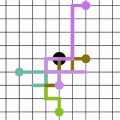Single particle tracking allows probing how biomolecules interact physically with their natural environments. A fundamental challenge when analysing recorded single particle trajectories is the inverse problem of inferring the physical model or class of models of the underlying random walks. Reliable inference is made difficult by the inherent stochastic nature of single particle motion, by experimental noise, and by the short duration of most experimental trajectories. Model identification is further complicated by the fact that main physical properties of random walk models are only defined asymptotically, and are thus degenerate for short trajectories. Here, we introduce a new, fast approach to inferring random walk properties based on graph neural networks (GNNs). Our approach consists in associating a vector of features with each observed position, and a sparse graph structure with each observed trajectory. By performing simulation-based supervised learning on this construct [1], we show that we can reliably learn models of random walks and their anomalous exponents. The method can naturally be applied to trajectories of any length. We show its efficiency in analysing various anomalous random walks of biological relevance that were proposed in the AnDi challenge [2]. We explore how information is encoded in the GNN, and we show that it learns relevant physical features of the random walks. We furthermore evaluate its ability to generalize to types of trajectories not seen during training, and we show that the GNN retains high accuracy even with few parameters. We finally discuss the possibility to leverage these networks to analyse experimental data.
翻译:单粒子跟踪可以检验生物分子如何与自然环境发生物理互动。 在分析所记录的单粒子轨迹时,一个根本的挑战就是推断基本随机行走的物理模型或模型类型。 单粒子运动的内在随机性质、实验噪音和大多数实验轨迹的短暂时间长度使得可靠的推论变得困难。 模型识别由于随机行走模型的主要物理特性仅被定为象征性的,因此在短轨轨道上会退化。 在这里,我们引入一种新的快速参数来推断基于图形神经网络(GNNSs)的随机行走特性。 我们的方法包括将每个观察到的位置和每个观察到的轨迹的微小的图形结构连接在一起。 通过在模拟的基础上监督地学习这一构造[1],我们显示我们可以可靠地学习随机行走的模型及其随机行走。 这种方法可以自然地应用于任何长的轨迹。 我们展示其分析随机行走的随机行走特性的效率,我们最终在分析各种实验性行走的轨迹时, 将显示我们如何理解这些行走的概率,我们如何理解这些行走方法。




